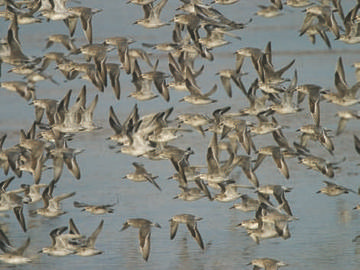Knot (Calidris canutus)

Knot © Steve Round
Eric Hardy, in his 1941 book The Birds of the Liverpool Area, evoked the image of Knot on Hoylake shore by describing ‘the flocks attaining cloud size and nearly a mile long at times’. This graphic depiction gives us no idea of numbers but the birds roosting on Hilbre and Little Eye were famous and attracted photographers including, over twenty times from 1946 onwards, Eric Hosking who mentioned a single pack of Knots numbering 50,000 (Hosking 1970). On 13 November 1965 ‘about 100,000 at Red Rocks was considered a very conservative estimate’ (CBR) but in the early 1970s the Knot population wintering in Britain roughly halved within three or four years, probably because of a series of unproductive breeding seasons, from which they never recovered (BTO Winter Atlas).
Before that drop in the British wintering population, the Dee flocks were already suffering human disturbance and in 1969 the annual bird report noted that ‘for some years past the huge numbers of Knot in the Dee Estuary had taken to ‘flying out’ the peak of the very high tides’, circling over the estuary rather than roosting on the small areas of land remaining. The pressure increased, day and night, from walkers, dogs, horses and sea anglers but the birds put up with it for more than ten years until, in 1980/ 81, Knot feeding in the Dee suddenly switched to flying to the Alt estuary to roost (Mitchell et al 1988). The feeding areas of the Dee, mainly Dawpool Bank off Heswall (SJ28F) and Mockbeggar Wharf off Leasowe (SJ29R) were obviously so productive – especially of their favourite food, the bivalve mollusc macoma – that the Knots were still attracted to them, but they used extra energy flying up to an extra 40 km round-trip twice a day to find a safe roost. Both sites, the Dee and the Alt, are vital for the species’ conservation and both have SSSI and SPA status for Knots.
Since the 1980s the Dee Estuary Voluntary Wardens have run a major campaign to try to educate those disturbing the birds and more birds now stay to roost on the north Wirral shore off Hoylake, but, for reasons unknown, they have not returned to the Hilbre Islands. On the highest tides, when there is least beach left, they still normally fly to the Alt. On the basis of WeBS counts the Dee estuary currently ranks sixth in the UK, with a five-year peak mean of over 30,000 birds (Musgrove et al 2006), although the figures fluctuate wildly from one year to another, from 5,000 to 50,000, depending on whether the feeding or roosting birds were counted. Some of these figures seem almost unbelievable, but, when roosting during high tides, Knot can pack into very tight flocks at amazing densities: I have calculated mean densities of twenty birds per square metre in some flocks caught for ringing.
The Atlas map shows Knots present in every tetrad in the Dee estuary and the north Wirral coast: the largest flocks were 22,400 in SJ29R in 2005/06 and 20,000 off the south of Hilbre (SJ18Y) in the same winter, with the same total also reported in 2004/ 05 from West Kirby shore (SJ28D) and Hoylake shore (SJ28E). Away from the Dee and north Wirral, Knots were found in thirteen tetrads in the Mersey, but numbers are very much lower. The peak Mersey count was 200 birds on Stanlow Banks (SJ47I) and about 100 in the Bromborough/ New Ferry areas (SJ38L/ M). Knot is a rare bird inland, and there was just one record of one bird, on 20 and 21 November 2004, at Elton Hall Flash, Sandbach (SJ75J).
The Knot that spend the winter here are of the islandica race that crosses the Atlantic to breed far to the northwest, even in ‘ultima Thule’ as with the bird ringed at West Kirby on 30 November 1970, found dead on 29 May 1972 in the Thule region of Greenland (76°34´N 68°48´W), 3694 km away. Merseyside Ringing Group has records of ten Knots ringed on the Dee and found in Greenland, with another 38 exchanges between the Dee and Iceland, used as a staging ground. One of them was ringed at Hoylake on 11 February 1970 and was in the west of Iceland just four days later, showing that, even in mid-February some birds are eager to get back towards their breeding areas, which extend as far as Ellesmere Island, Canada. The UK is of particular importance for the islandica Knot, with at least two-thirds, and sometimes up to 90%, of the entire population wintering here; the proportion appears to have been increasing lately owing to redistribution of birds from The Netherlands and Germany, with Knots now tending to winter slightly closer to their breeding grounds. Once here for the winter, birds generally stay put but might move south to France if severe weather closes in, as with the bird ringed at West Kirby beach on 6 November 1964 that was reported from the Vendee, 794 km south, on 31 December the same year.
Sponsored by David and Fran Cogger in memory of Sam

